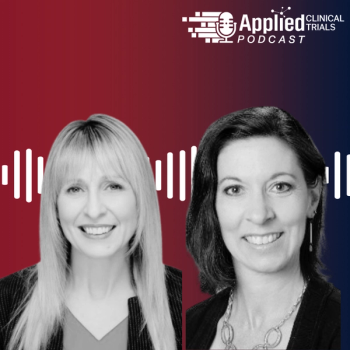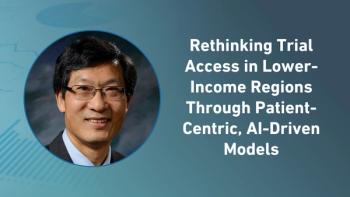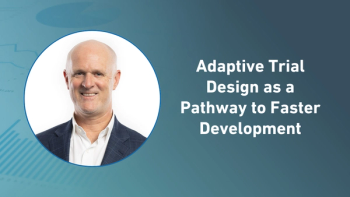
- Applied Clinical Trials-09-01-2022
- Volume 31
- Issue 9
‘Record’ Gains in Bringing Research Closer to the Patient
Experts discuss solving the EHR-compatibility puzzle in point-of-care trials.
Editor’s note: Industry recognition for the clinical research as a care option, or CRAACO, movement goes to The Conference Forum, which has hosted the conference of the same name, for seven years. This year’s CRAACO event was held Sept. 12 and Applied Clinical Trials, at the time of this writing, is looking forward to attending and learning more from many of the speakers featured in this article.
At the Icahn School of Medicine at Mount Sinai, researchers are laying the groundwork for future massive genotype-based studies. Within three to six years, the database is expected to hold the sequenced DNA samples of one million people—all patients of the Mount Sinai Hospital System.
In Oregon and California, researchers wanted to see if people who were overdue for a colon cancer screening test would take one if they were mailed a FIT test. It took one year to identify 41,193 people in 26 federally qualified health clinics.1
And in the Northwell Health System, researchers culled their electronic health record (EHR) system for patients with specific COVID-19 symptoms to help them determine whether the use of famotidine would shorten the number of days a COVID patient contended with symptoms. They found 55 fitting the bill within six weeks.2
At the University of California, San Francisco, and across the country at Temple University Hospital, oncologist researcher Laura Esserman, MD, MBA, and pulmonologist Gerard Criner, MD, respectively, have been using their EHR systems for years to run pragmatic trials and to find eligible clinical trial patients in their respective clinics.3,4 Once found, the medical teams embed the trial into patient care.
If you are wondering if this article concerns EHRs and compatibility, you’d be correct. If you are thinking it concerns ways in which clinical trials can be run with less money and fewer data points, you’d also be accurate. And if you think it’s about improving patient care where they receive care—all while advancing research—you are spot on.
What these researchers are doing bears little resemblance to the classic, rigidly run, interventional clinical trial. Trial phases blend into one another. In some cases, molecules under inspection that aren’t working are eliminated as early as possible from the trial; molecules that do work are tested under more scrutiny. With clinical trials, time means money.
A key point: All enrolled patients were found after serious mining into the provider’s EHR. So yes, point of care works in large healthcare establishments, with fluid EHR systems. So yes again, point of care is not a routine approach in most trials. A serious problem, says Amy Cramer, steering committee board co-chair for the HL7 FHIR Accelerator Vulcan, is that most trials are still conducted using paper processes. Researchers need the data before the trial is started, she adds.
It is all about the technology, Christina Brennan, MD, vice president, clinical research at Northwell Health, tells Applied Clinical Trials. “We wouldn’t have been able to do [the famotidine trial] without” the EHR system, she says. Everything Northwell could determine about its potential recruitment prospects came from its system, as did all inputted data that led to results. “We screened thousands of patients for eligibility.”
At Temple University Hospital, running trials and treating patients have gone hand in hand for a few years. “Our clinical research program is not separate from our clinical care or our academic mission,” said Criner, also chair and professor, Thoracic Medicine and Surgery, Lewis Katz School of Medicine at Temple University; and director, Temple Lung Center, in a published interview3, who also reviewed this included information for accuracy. “If you embed it into your care program and your care program has to address what the needs of the patient community you treat are, you can’t help but make everything better—your research, clinical care, and training.”
As to what this clinical trial approach is called, there is no universal name. Brennan says she didn’t think point of care was applicable, and preferred clinical research as a care option, or precision/personalized medicine.
According to FDA—which, by the way, is a big supporter of embedding clinical research at the point of care–“Point of care trials take place in a clinical practice environment and make use of clinical infrastructure and personnel for trial-related activities.” A successful trial, an agency spokesperson continued, “may shorten the time needed to obtain safety and efficacy data for medical products.”
But do not think these trials are allowed to confuse real-world data (RWD) with real-world evidence (RWE). FDA, in its 2018 framework document,5 defined RWD as the data relating to patient health status and/or the delivery of health care routinely collected from a variety of sources, and RWE is the clinical evidence regarding a medical product’s use and potential benefits or risks derived from analysis of RWD.
Says researcher Rachele Hendricks-Sturrup, DHSc, research director for real-world evidence at the Margolis Health Center at Duke University: "Healthcare data is not real-world evidence until it is analyzed and assessed alongside other sources of real-world data.”
Taking the 30,000-foot view, Jodyn Platt, PhD, MPH, an assistant professor of learning health sciences at the University of Michigan, says health care should be viewed as a point of learning. “There’s a fine line between quality improvement and research” in order to learn from that data to give better care.
But it could be worth it, Platt says. If researchers have the opportunity to use a system that allows them to see what is done correctly or not, “we have the potential for making the [healthcare system] better for everyone,” she says. “If we can think strategically, we can make the process better.”
One process
Esserman, who built her approach to breast cancer trials in the early 2010s, described how the process works at the UCSF Breast Cancer Center. All registration data are collected and cleaned within 24 hours.4
Each patient’s information regarding response to the therapy is used to build on to the next patient. This is all about finding early indicators of response and eliminating data detritus, which, says Esserman, clouds results.
The idea, she adds, is to have real-time data collection. “All data sets must be complete before randomization,” Platt says. “We are trying to focus on the data that inform the primary endpoints, so that we are less burdened with data of ancillary interest.”
She elaborates that most data, 90%, collected in trials is irrelevant because it is never used or “not germane to the primary endpoint.” And since all data collection requires time and money, more thoughtful decisions about what to collect matters.
It is a model other are adopting or participating in, including FDA and the National Cancer Institute.7
Examples of embedded trials
In Northwell’s double-blind, placebo-controlled study on famotidine, researchers collected 1,358 data points from 55 patients with COVID; one arm got the famotidine, the other, placebo. Those in the control arm improved three days more quickly. All samples and all treatment were administered in the patients’ homes. The cost of the trial was less than $1.5 million.2 The success of the study and its cheaper cost have convinced Northwell that the model is worth incorporating into their trial formats. Along with this more patient-centric approach, Brennan says that hybrid trials are being requested more by sponsors.
Between 2014 through 2016, Mount Sinai used EHRs to find 2,050 patients of West-African ancestry with hypertension, no chronic kidney disease, and genotyped them for the APOL1 risk variant, which could be deadly for those subgroups.6 Once patients were found through the EHRs, study coordinators mailed invitations and then followed up with phone calls of those who declined, “and intercepted potentially eligible patients at clinics when they were hard to reach,” according to the study. The point of the trial was to quickly return genetic results to a randomized group to see how patient outcomes would be affected.
The intervention group reduced their blood pressure and adopted more healthy behaviors. The high-risk patients dropped their systolic blood pressure by 3.6%; the controls dropped by 1.3%.
“These results may support an approach of broad implementation of genetic medicine in primary care for certain use cases,” concluded Girish N. Nadkarni, MD, MPH, Irene and Dr. Arthur M. Fishberg professor of Medicine, Icahn School of Medicine at Mount Sinai, et al., in the study.6
The issues
As to the question of just how common point of care trial research actually is, everyone interviewed had the same answer—it isn’t.
“There is a lot of activity in this space. But it is fragmented, as is our healthcare system,” says Platt. Her specialty is studying trust in the US healthcare system. Developing measures of trust to monitor how trial enrollees are faring is in the works, she she adds. “It is a huge issue because of digital care in the home.” What happens to the data if third parties are involved, or if a startup company that was monitoring patient progress dissolves? “How does your data live with this?” asks Platt.
She and her staff are starting research in artificial intelligence and how patients trust the technology in their healthcare systems. “That is a key research question—it’s a new form of technology that has little oversight, from institutions and government. We need to understand what the public feels like when they have a stake in the field.”
Models, theories, and blips
In May, the Duke University Margolis Center for Health Policy published a white paper on point of care-incorporated trials.8 It defined one aspect of the point-of-care scenario as: Using an EHR for enrollment, data collection, and randomization; running the trial where patient care occurs; and combining research and clinical care delivery workflows. “The focus is on the trial participants,” says Hendricks-Sturrup, a co-author. “We want to achieve better screening, consent, randomization, and data collection, then incorporating those finds into routine care.”
The difference between other trial designs and those that use point of care, says Hendricks-Sturrup, is that point of care is designed “to know if the therapy is efficacious across all populations.”
Margolis is working to resolve issues that could impede point-of-care progress, such as who runs the trial, who should pay for it, and how can data be collected and handled in an easy fashion across different systems? A major point is not adding burden to providers. “We are working to tackle policy,” says Trevan Locke, PhD, assistant research director for Margolis.
As for the blip, researchers for the colon cancer screening trial learned that buy-in from staff involved in the trial is essential. Staff at the various federally qualified health clinics didn’t all do as the researchers asked, like installing a piece of software into their EHRs to find and track possible participants. Researchers stated: “For most of the participating health centers, [this trial] represented the first time EHR tools were used to deliver cancer screening services outside the clinic. Implementation might have increased
with experience.”1
In the future
Alexander Charney, MD, PhD, associate professor, departments of psychiatry and genetics and genomic sciences, and co-director of the Mount Sinai Million Health Discoveries Program, says that as it acquires patient samples, it is gaining approvals for future trials. No studies are established yet, he says.
“But let’s fast-forward five years,” Charney continues. A sponsor wants to run a trial comparing therapy X to therapy Y, when half of the patients have a certain genetic variant. “If a researcher wants to do that trial, five years from now, patients will already have consented,” he adds. “We have laid the groundwork.”
All 17 hospitals and clinics in the Mount Sinai Health System will be recruiting for this project, which is being underwritten by Regeneron. The volume of patients and unification of Mount Sinai’s operations make the enrollment goal possible, says Charney. His fellow co-director, Nadkarni, says enrollment is going slowly for a purpose.
“We want to make sure systems are good to go,” he tells Applied Clinical Trials, and that safeguards are working, like ensuring patients are not duplicated in the system. The platform, he notes, meets all NIH and Department of Defense security standards.
Partnering with Regeneron, says Charney, was key to getting the project off the ground. “There is no other way to sequence the genome of one million people,” he adds. Regeneron, notes Nadkarni, will sequence the DNA samples, and then return the patient data.
At Northwell, Brennan said that as each trial request comes in, the team is looking at whether an embedded study can work. Of the 2,000 trials in motion, 5% to 8% are designed as a hybrid approach. Despite all the talk about embedded, i.e., point of care, few are being run that way.
But, she adds, “We don’t want to go back to the former ways and traditional methods of running a trial. When we saw how to pivot in COVID, we were able to [be flexible].”
Christine Bahls is a freelance writer for medical, clinical trials, and pharma information.
References
- Coronado GD, Petrik AF, Vollmer WM, et al. Effectiveness of a Mailed Colorectal Cancer Screening Outreach Program in Community Health Clinics: The STOP CRC Cluster Randomized Clinical Trial. JAMA Intern Med. 2018;178(9):1174–1181
- Brennan CM, Nadella S, Zhao X, et al. Oral famotidine versus placebo in non-hospitalized patients with COVID-19: a randomized, double-blind, data-intense, phase II clinical trial. Gut. May 2022;71(5):879-888. doi: 10.1136/gutjnl-2022-326952. Epub 2022 Feb 10. PMID: 35144974; PMCID: PMC8844971.
- CRAACO newsletter Autumn 2020. Pp17-18
https://theconferenceforum.org/wp-content/uploads//2020/09/CRAACO_Q3-1.pdf - Interview with Laura Esserman. The I-SPY Approach to Drug Development. Clinical Advances in Hematology & Oncology October 2016, Volume 14, Issue 10
- FDA (
https://www.fda.gov/media/120060/download ) - Nadkarni GN, Fei K, Ramos MA, et al. Effects of Testing and Disclosing Ancestry-Specific Genetic Risk for Kidney Failure on Patients and Health Care Professionals: A Randomized Clinical Trial. JAMA Netw Open. March 2022
- QUANTUM LEAP
https://www.quantumleaphealth.org/about-us/board-of-directors - Point-of-Care Clinical Trials: Integrating Research and Care Delivery. Duke Margolis Center for Health Policy. May 11, 2022.
https://healthpolicy.duke.edu/publications/point-care-clinical-trials-integrating-research-and-care-delivery
Articles in this issue
about 3 years ago
The Powerful Impact of Caregivers on Clinical Trialsabout 3 years ago
Clinical Research Needs Greater Participant Diversityabout 3 years ago
The Eradication of False Signals in Monitoringabout 3 years ago
Contemplating a Pressing Drug Development Paradoxabout 3 years ago
Evaluating the Use of Backup Solutions for ePRO Systemsabout 3 years ago
Filling the Gaps in Clinical Trial Education, Literacyabout 3 years ago
CRAACO, Moving Trials Closer to Patientsabout 3 years ago
Applied Clinical Trials September 2022 Issue (PDF)about 3 years ago
Getting Up to Speed on EU’s New Trial Application Systemover 3 years ago
Top Priority for Califf is Combating Health MisinformationNewsletter
Stay current in clinical research with Applied Clinical Trials, providing expert insights, regulatory updates, and practical strategies for successful clinical trial design and execution.






.png)



.png)



.png)
.png)
